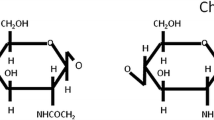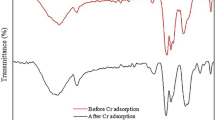Abstract
Schinopsis brasiliensis Engler is a plant of Anacardiaceae family, used in the treatment of various diseases. Dried extracts have been used as intermediate product to obtain different pharmaceutical forms. Microparticles are a controlled-release system that protects unstable materials, and assist in increasing bioavailability parameters, while still allowing release to the specific site. This study aimed to trace the profile of microparticles of thermal degradation produced with S. brasiliensis Engl. extract in a chitosan matrix, evaluating some microparticles parameters (encapsulation efficiency, zeta potential, polydispersity index and SPAN factor). Thermal behavior of microparticles showed chitosan is able to protect the S. brasiliensis extract. Encapsulation efficiency and zeta potential are not directly proportional to flow rate, differently to polydispersity index and SPAN factor. This study showed the chitosan potential to protect S. brasiliensis extract of thermal degradation, allowing future applications.


Similar content being viewed by others
References
Fernandes FHA, Santana CP, Santos RL, Correia LP, Conceição MM, Macêdo RO, Medeiros ACD. Thermal characterization of dried extract of medicinal plant by DSC and analytical techniques. J Therm Anal Calorim. 2013;113:443–7.
Almeida CFCBR, Lima e Silva TC, Amorim ELC, Maia MBS, Albuquerque UP. Life strategy and chemical composition as predictors of the selection of medicinal plants from caatinga (Northeast Brazil). J Arid Environ. 2005;62:127–42.
Albuquerque UP. Re-examining hypotheses concerning the use and knowledge of medicinal plants: a study in the Caatinga vegetation of NE Brazil. J Ethnobiol Ethnomed. 2006;2:30.
Albuquerque UP, Medeiros PM, Almeida ALS, Monteiro JM, Lins-Neto EMF, Melo JG, Santos JP. Medical plants of the caatinga (semi-arid) vegetation of NE Brazil: a quantitative approach. J Ethnnopharmacol. 2007;114:325–54.
Agra MDF, Baracho GS, Nurit K, Basílio IJLD, Coelho VPM. Medicinal and poisonous diversity of the flora of “Cariri Paraibano”, Brazil. J Ethnopharmacol. 2007;111:383–95.
Silva MSP, Brandão DO, Chaves TP, Formiga Filho ALN, Costa EMMB, Santos VL, Medeiros ACD. Study bioprospecting of medicinal plant extracts of the semiarid northeast: contribution to the control of oral microorganisms. Evid Based Complement Altern Med. 2012. doi:10.1155/2012/681207.
Fernandes FHA, Almeida VE, Medeiros FD, Silva PCD, Simões MOS, Veras G, Medeiros AC. Evaluation of compatibility between Schinopsis brasiliensis Engler extract and pharmaceutical excipients using analytical techniques associated with chemometric tools. J Thermal Anal Calorim. 2016;123:2531–42.
Chaves TP, Barbosa AS, Nunes LE, Silva KMA, Simões MOS, Santos RL, Catão RMR, Santos VL, Medeiros AC. Evaluation of the potential modulator of bacterial resistance, acute toxicity and chemical composition of Schinopsis brasiliensis Engl. Afr J Pharm Pharmacol. 2015;9:843–9.
Cardoso MP, David JM, David JP. A new alky phenol from Schinopsis brasiliensis. Nat Prod Res. 2005;19:431–3.
Cardoso MP, Lima LS, David JP, Moreira MO, Santos EO, David JM, Alves CQ. A new biflavonoid from Schinopsis brasiliensis (Anacardiaceae). J Braz Chem Soc. 2015;26:1527–31.
Fernandes FHA, Batista RSA, Medeiros FD, Santos FS, Medeiros ACD. Development of a rapid and simple HPLC-UV method for determination of gallic acid in Schinopsis brasiliensis. Rev Bras Farmacogn. 2015;25:208–11.
Silva KMA, Chaves TP, Santos RL, Branão DO, Fernandes FHA, Ramos-Júnior FJL, Santos VL, Felismino DC, Medeiros ACD. Modulation of the erythromycin resistance in Staphylococcus aureus by ethanolic extracts of Ximenia americana L. and Schinopsis brasiliensis Engl. B Latinoam Caribe Pl. 2015;14:92–8.
Donati M, Mondin A, Chen Z, Miranda FM, Nascimento Júnior BB, Schirato G, Pastore P, Froldi G. Radical scavenging and antimicrobial activities of Croton zehntneri, Pterodon emarginatus and Schinopsis brasiliensis essential oils and their major constituents: estragole, trans-anethole, B-caryophyllene and myrcene. Nat Prod Res. 2014. doi:10.1080/14786419.2014.964709.
Saraiva AM, Saraiva CL, Cordeiro RP, Soares RR, Xavier HS, Caetano N. Atividade antimicrobiana e sinérgica das frações das folhas de Schinopsis brasiliensis Engl. frente a clones multirresistentes de Staphylococcus aureus. Rev Bras Plantas Med. 2013;15:199–207.
Saraiva AM, Castro RHA, Cordeiro RP, Peixoto Sobrinho TJS, Castro VTNA, Amorim ELC, Xavier HS. Pisciottano MNC. In vitro evaluation of antioxidante, antimicrobial and toxicity propeties of extracts of Schinopsis brasiliensis Engl. (Anacardiaceae). Afr J Pharm Pharmacol. 2011;5:1724–31.
Figueiredo EC, Dias ACB, Arruda MAZ. Molecular Imprinting: a promising strategy in matrices elaboration for drug delivery system. Rev Bras Cienc Farm. 2008;44:361–75.
Benita S. Microencapsulation: methods and industrial applications. 2nd ed. Jerusalem: Culinary and Hospitality Industry Publications Services (C.H.I.P.S.); 2005. p. 784.
Correia LP, Procópio JVV, Santana CP, Santos AFO, Cavalcante HMM, Macêdo RO. Characterization of herbal medicine with different particle sizes using pyrolysis GC/MS, SEM and thermal techniques. J Thermal Anal Calorim. 2011;111:1691–8.
Barbosa MIMJ, Borsarelli CD, Mercadante AZ. Light stability of spray-dried bixin encapsulated with different edible polysaccharide preparations. Food Res Int. 2005;38:989–94.
Ge H, Wang S. Thermal preparation of chitosan-acrylic acid superabsorbent: optimization, characterization and water solubility. Carbohydr Polym. 2014;113:296–303.
Sinha VR, Singlaa K, Wadhawan S, Kaushik R, Kumria R, Bansal K, Dhawan S. Chitosan microspheres as a potential carrier for drugs. Int J Pharm. 2004;274:1–33.
Gámiz-González MA, Correia DM, Lanceros-Mendez S, Sencadas V, Gómez Ribelles JL, Vidaurre A. Kinetic study of thermal degradation of chitosan as a function of deacetylation degree. Carbohydr Polym. 2017;167:52–8.
Nam YS, Park WH, Ihm D, Hudson SM. Effect of the degree of deacetylation on the thermal decomposition of chitin and chitosan nanofibers. Carbohydr Polym. 2010;80:291–5.
Pereira GG, Santos-Oliveira R, Albernaz MS, Canema D, Weismüller G, Barros EB, Magalhães L, Lima-Ribeiro MHM, Pohlmann AR, Guterres SS. Microparticles of Aloe vera/vitamin E/chitosan: microscopic, a nuclear imaging and an in vivo test analysis for burn treatment. Eur J Pharm Biopharm. 2014;86:292–300.
Wang SF, Shen L, Tong YJ, Chen L, Phang LY, Lim PQ. Biopolymer chitosan/montmorillonite nanocomposites: preparation and characterization. Polym Degrad Stab. 2005;90:123–31.
Rodrigues RAF, Rodrigues MVN, Oliveira TIV, Bueno CZ, Souza IMO, Sartoratto A, Foglio MA. Docosahexaenoic acid ethyl esther (DHAAE) microcapsule production by spray-drying: optimization by experimental design. Cienc Tecnol Aliment. 2011;3:589–96.
Özyildiz F, Karagönlü S, Basal G, Uzel A, Bayraktar O. Micro-encapsulation of ozonated red pepper seed oil with antimicrobial activity and application to nonwoven fabric. Lett Appl Microbiol. 2013;56:168–79.
García-Saldanha JS, Campas-baypoli ON, López-Cervantes J, Sánchez-Machado DI, Cantú-Soto EU, Rodríguez-Ramírez R. Microencapsulation of sulforaphane from broccoli seed extracts by gelatin/gum arabic and gelatin/pectin complexes. Food Chem. 2016;201:94–100.
Souza PMS, Lobo FA, Rosa AH, Fraceto LF. Development of nanocapsules of poly-ε-caprolactone containing herbicide atrazine. Quim Nova. 2012;35:132–7.
Author information
Authors and Affiliations
Corresponding author
Rights and permissions
About this article
Cite this article
Sette-de-Souza, P.H., Medeiros, F.D., Santana, C.P. et al. Thermal decomposition profile of chitosan microparticles produced with Schinopsis brasiliensis Engler extract. J Therm Anal Calorim 131, 829–834 (2018). https://doi.org/10.1007/s10973-017-6456-4
Received:
Accepted:
Published:
Issue Date:
DOI: https://doi.org/10.1007/s10973-017-6456-4




